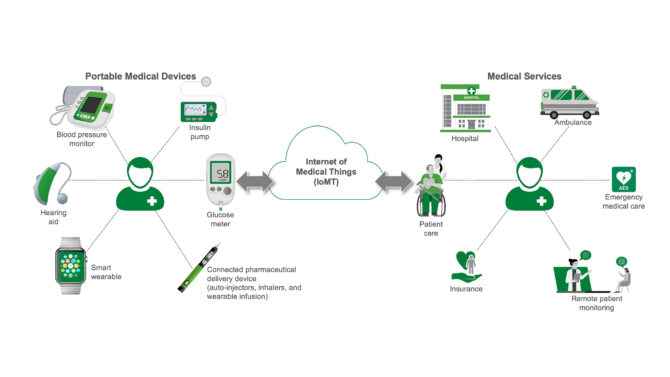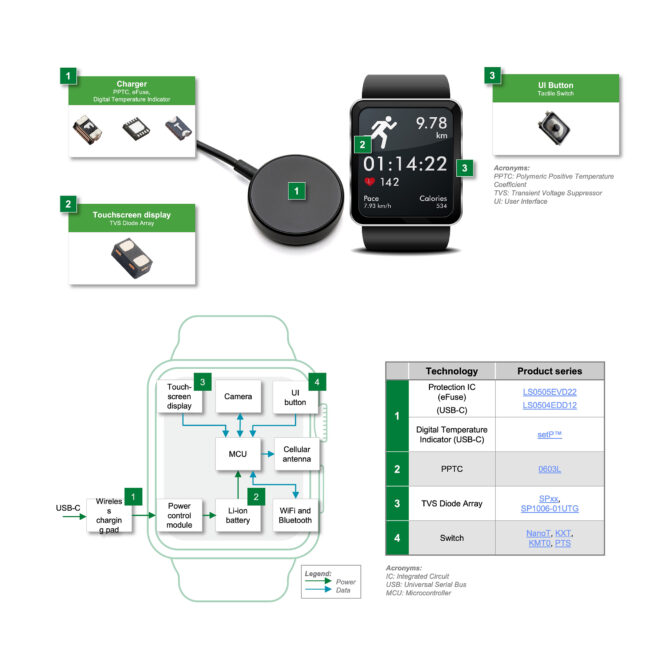
Keeping healthcare designs healthy
By Roger Bohannan, Littelfuse
Circuit Protection Electronics Medical circuit protection healthcare littelfuse medicalProtecting portable medical devices in the age of connectedness
Healthcare has benefitted tremendously from advances in electronic and communication technologies. IoT communications technology and advancements in semiconductor electronics have resulted in compact, lightweight, wearable medical devices connected to the Internet. Personal wearable and connected instruments allow continuous monitoring, greater individual awareness of existing health conditions, automated administration of tests and medication and instant access to medical care personnel.
The challenge in developing these products is ensuring high reliability, as they must function on a 24/7 basis. The designer needs help minimizing product size and maximizing battery life efficiency while ensuring robustness from electrical hazards. Wearable health monitors provide activity reminders, data on exercise, and some health parameters. For example, an IoT-based smart wearable device includes critical circuitry where designers can improve ruggedness and reliability with the recommended technologies.

Connected healthcare – portable medical devices and IoT. Source: Littelfuse
The circuitry that benefits from these improvements includes the wireless charger, battery pack,
touchscreen display and user interface. The Wireless Charger provides current to charge the battery and gets power from a USB-C source that can generate up to 20Vdc and 5Vac. A failure in the charger can result in substantial overcurrent. An overcurrent protection device, such as a fuse or a polymer positive temperature coefficient (PPTC) resettable fuse, can ensure the necessary overcurrent protection.
ESD damages devices
Electrostatic discharge (ESD) can severely damage devices unless they have overvoltage protection. Transient voltage suppressor (TVS) diodes can provide overvoltage protection by clamping the transient voltage at a safe level and absorbing the current surge, which can be in the kA range. While multiple components can provide protection, protection ICs combine overcurrent protection, overvoltage protection, overtemperature protection, and other protection modes.
High density connector
USB Type-C is a high-density, multi-pin connector with narrow pin spacing, which can subject the connector to shorts due to dust and dirt, reducing the insulation resistance between pins. Digital temperature indicators protect USB cables from damage due to shorted pins.
Battery pack protection
A Lithium-ion battery pack powers the health monitor. Current overloads can cause the battery to overheat and fail. A fast-acting PPTC resettable fuse is an excellent option. Types of PPTC fuses can switch to a very high resistance state in a second or less in the event of an overcurrent of two to 10 times the rated hold current. Power dissipation through the PPTC is around 0.5W to minimize power consumption. The fuse is small, (1.5 x 0.8mm), space-saving, surface mount package. The touchscreen display is the user interface to the health monitor’s functional controls and analytics information.

Smart health wearable monitor only delivers benefits if it. Source: Littelfuse
ESD, primarily from human contact, can damage the touchscreen’s functionality and make the health monitor inoperative. TVS diodes can help prevent failure due to ESD. Various types of TVS diodes can absorb as much as a 30kV discharge from contact through a user. These components can have low leakage current, typically less than 0.5μA, to minimize the current draw on the battery. TVS diode models, available in small 0201 surface mount packages, can have parallel capacitance as low as 15pF to not impact the integrity of digital signal lines.
For safety certification, ensure the TVS diode complies with IEC 61000-4-2 for ESD protection. The User Interface Button allows the user to control the functions of the health monitor. Switches with protection from moisture and long operating life can ensure a reliable health monitor.
Look for switches that offer at least IP67 protection from the environment. Employing the recommended components can help protect the health monitor from electrical hazards. It only takes a few components to ensure a robust design for a wearable health monitor.
Protecting a hearing aid
Hearing aids must also be robust and reliable, therefore circuit protection and efficient control should improve product reliability. The Volume Control and pushbutton should include long-life switches protected from the external environment. Designers have several options for switching styles.
Protecting USB interfaces from ESD requires TVS diodes as recommended for the health monitor touchscreen circuit. Use two diode TVS in an anode-to-anode connection for bi-directional protection on the USB data lines. Some TVS diodes have an ultra-small 01005 flipchip package. The main power for the hearing aid comes from the USB Type-C port, which provides the battery charging current.
A simplified alternative for the protection of the USB interface is a PPTC resettable fuse, which equips the hearing aid with overcurrent protection. While a PPTC fuse only provides overcurrent protection, it has the benefit of consuming a small amount of pcb space and minimal battery power. Versions of PPTC resettable fuses come in 0402 surface mount enclosures and can have resistances in the single-digit milliohm range.
Wearable medical devices only provide their benefits if they function reliably. Only a few components are required to help ensure a robust product.
With the benefits of the unique components and assistance from the component manufacturers, designers can achieve their objective of developing an efficient, protected, wearable medical device. The result is a more robust and reliable product for the customers.
——————————–
*This article was written and submitted by Littelfuse Inc., a Chicago-based producer of circuit protection products.
